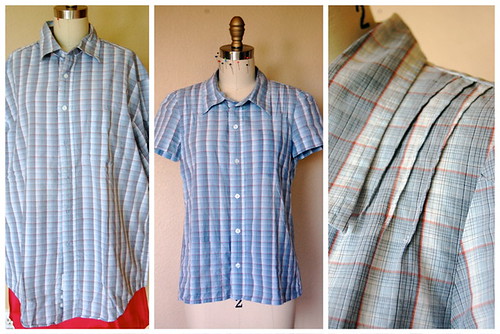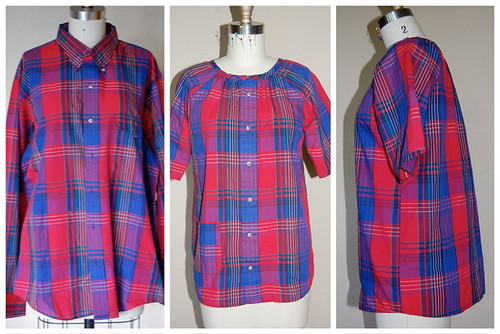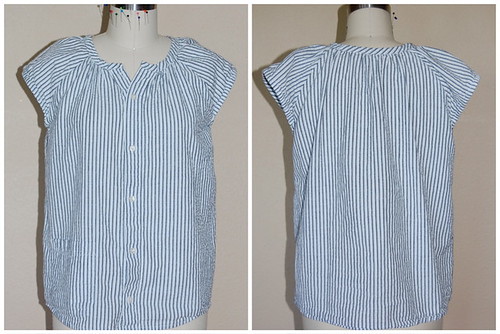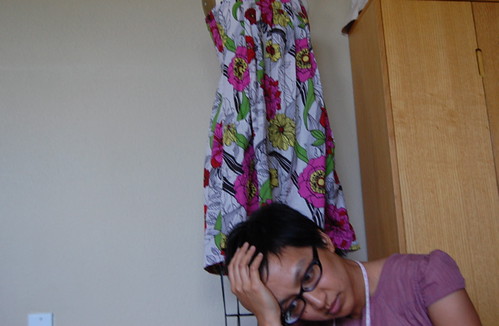1) THANK YOU
It has been a lot of fun to kick off Vocabulary and read your many supportive, encouraging comments... to see how many of you became Facebook fans, how many of you re-tweeted the shop opening announcement, how many of you wrote a whole new blog post to share the news! I've always enjoyed finding a place in the blogging community and making new friends in a new way. Launch weekend could have been way stressful but it ended up being very exciting and fun. Thank you for your friendship.
2) A disclaimer
This is my third time writing this post -- I actually deleted the first two drafts and started fresh each time. Because I am blogging about 3 tops, two of which I really don't care much for, and it made me tired to re-live the experience draping/ drafting/ sewing them up. And I thought if it was deflating for me to show you the pics and describe the challenges, maybe it would be deflating for you to see and read about them. But I've decided to document some of my lessons learned anyway in case they are interesting or helpful to you (and you can just close the window now and wait for the next post if you like, I would understand!).
3) Refashion 26: Pintucked (Shoulder) Shirt from Men's Dress Shirt
This was my first design idea for Vocabulary's summer camp shirt variations. The original was a 100% cotton, short-sleeved men's shirt. The resulting women's shirt was challenged:
- Shoulders too wide
- Neckline too big, odd shape shape (the shirt started out collarless but I didn't like it, unpicked the binding, adjusted the original collar and sewed it on)
- Silhouette boxy, unflattering
- You can't see the pintucks on most patterned fabrics unless you're up close
So I ditched the whole concept. I'd tortured the fabric on this sample enough and still couldn't get the shirt where I wanted it. I've worn the shirt a few times and you know what? It isn't really comfortable! So I moved on to the next style without tinkering with the pattern/ first sample more.

4) Refashion 27a: Gathered Raglan Top from Men's Dress Shirt
This eventually became the Dulcet Top that's in the shop. But getting there was pretty much torture for me. In summary, the process for this top was:
- Sketch the design
- Drape a sample
- Transfer to pattern
- Sew the first sample
- Refine the sample
- Alter the pattern
- Sew the second sample
- Refine second sample
- Alter the pattern
- Sew the third sample, refine it, alter the pattern
- Lather, rinse, repeat
- Sew the top in its final form
- Then grade the pattern into multiple sizes, but I'll get to that later
Honestly, I wasn't unhappy with this first sample. I like wearing it and have gotten compliments. But when I thought about how much better it needed to be in order to be sustainable, a closet staple someone else would love and pretty much wear to death, it needed some changes:
- Silhouette is straight from the front but a-line when looking from the side. Decided to make the whole thing a-line and hit at high hip.
- Neckline was higher than I wanted it to be.
I thought I'd make those changes, make a perfect second sample, and we'd be ready to production sew! Not the case.

5) Refashion 27b: Gathered Raglan Top from Men's Dress Shirt
Well, just look at it. Not ideal. When you mess with patterns, there's a very real chance that when you change one thing, it will affect something else that you might not have considered. I'm pretty comfortable modifying patterns for tops with set-in sleeves, but obvz. was thrown by the raglan style:
- Neckline binding too short
- Too much fabric in the sleeves
- Never again use seersucker for this top b/c the fabric is too stiff, won't drape well

I didn't photograph the third sample because it is pretty close to the final Dulcet top. Anyway, the point is it took 4 samples to get it just as I wanted it. Which is why people work far, far in advance of the season they are designing for. Which is why I learned my lesson and am working on Fall/ Winter ideas now, as I boil. (BTW, 52 days over 100 degrees so far this summer.)
6. Pattern grading
For the average home sewist, pattern grading is about using a commercial sewing pattern and drawing a new line from a smaller size for bust to a larger line for hips, or something to that effect. Maybe it means buying a sweet vintage pattern that's too big and drawing a new set of seamlines to get one size smaller.
Until this experience I had never done the manual pattern grading, garment industry-style, for multiple sizes. This involves taking your sample pattern, which is usually in the middle of your size range, cutting it along various vertical and horizontal lines, and separating by fractions of an inch to grade up, or overlapping by fractions of an inch to grade down.
Now that I've done it, I could grade another pattern much more quickly and less painfully. But that first time, it was tough. I felt overwhelmed by the many pattern pieces now scattered about the floor like a puzzle. Louis was walking around the house with my camera, practicing his composition, and he snuck up on me and took this picture, which in retrospect says it all:
There are many more lessons to share, but another time. :)





Oh, my dear Antoinette... You are seriously the hardest working woman I know! Your perseverence, attention to detail and perfectionist tendencies make me feel like a slacker! You are teaching me so much and I'm glad to be following your journey. :)
ReplyDeleteRunning a small business presents so many learning experiences. i can totally relate to that photo!
ReplyDeleteyou are so kind and generous to share your successes and difficulties for all of us to learn from.
ReplyDeletei like the picture of you deep in thought. is that a cloth tape measure hanging around your neck?!
Although they all look good to me, it is a difficult task to keep going on a project that you start to dislike. For me anyway, but perhaps I get discouraged too easily.
ReplyDeleteThanks for sharing!
I love the before and after pictures of your re fashioning. I could use some extended pattern grading experience....
ReplyDeleteAntoinette-Did you use a reference book for pattern grading???
ReplyDelete@glam.spoon - Tina, your generosity always makes me feel better! I wish I were naturally that detail oriented... normally just when I sew. I think the part that wore me out was never feeling like I was going to reach the finish line with a solid pattern!
ReplyDelete@Anonymous - Yes, learning experiences abound, both from mistakes and successes. :)
@bookwormbethie - Not a cloth tape measure, just the standard fiberglass-filament kind I guess. I have three different tape measures hanging around at any given time.
@Sarah - I really learned that the pattern refining and sample sewing can do me in. Not 100% sure how I will resolve this long-term. It helps that I only worked on 2 styles for this shop opening but I always have many more ideas.
@JoanneM - I have a few books that explain pattern grading in a very confusing way. The instructions I ultimately used came from Threads -- it seemed to have the same information/ grading chart as in the books, but the explanations were a little clearer. I will try to dig through the piles of scraps and remnants and patterns in my sewing room to see what issue that was, and I'll let you know. :)
I hear your pain! After all the work I have had to do refashioning one Chanel jacket I now have a fresh appreciation of all the challenges involved in working with a limited amount of fabric! It's amazing what you do.
ReplyDeleteOh well done - full respect for persistance and for telling the story. It is always much easier to let it 'seem' that somehow it always just worked out. so great for us learners and slackers to see how you suffer and keep going!
ReplyDeleteGreat news on the shop also!
x
Very interesting. I am actually on the hung for Threads #101 and #76, which of course I don't have in my Threads stash. I learned somewhere that those issues contain good grading info. Em from Em-in-the-studio.blogspot.com recently posted some grading info that put me on the hunt for resources. Is your Threads one of those issues?
ReplyDeleteaw! keep your chin up, your work is beautiful and (if the dress in the background is any indication) will fly off the shelves in no time!!
ReplyDeleteAwwww...that picture that Louis took is great capture of a moment in time!!!
ReplyDeleteThis comment has been removed by a blog administrator.
ReplyDeleteThis why, even though I love fashion, I would never want to be a fashion designer - even if I was any good at it.
ReplyDeleteYou learned a lot from your trials so the processes will only get easier.
I think that's one of the hardest things about sewing-related and other crafty blogging--admitting when a project doesn't go well. But the projects that fail are often the ones that I learn the most from. So kudos to you for letting us in on your process! And good luck with the pattern grading-- I wish I could offer suggestions, but I'm clueless!
ReplyDelete@Mary Nanna - Thanks, girl -- I hadn't even gotten to the part about all the lessons I learned about refashioning for production sewing! But you know it's coming!
ReplyDelete@Umatji -- You got me thinking more about blogging the failures... more to come, prob. in the next post. Thanks for your comment.
@Faye Lewis -- I guess I need to clean the sewing room at this point. I have no idea where that article is, because there are several piles on the floor now, as well as on the cutting table (which is why I am now laying things out on the ironing board! Ack!). I will look this weekend and send you an email when I find it.
@Columbia Lily -- Thanks, dear. Still keeping my chin up. ;)
@Kyle -- I just stumbled across the "frustration" photo while trying to find a couple of the "before" photos in iPhoto. Just kind of spontaneously decided to share. I don't think he knew how much he as capturing in this shot! LOL
@Violet -- I think this experience is mainly an indie designer experience. Designers at the big fashion houses and manufacturers sketch out their ideas and *maybe* do a line drawing and outline some specs, but other people (not like me, but those with a natural inclination toward details) draft patterns and sew up samples. But yes, I hear what you're saying, totally. And I think it will get easier, or at least I'll make different decisions moving forward.
@Becky -- Thank you. I don't think of these as failures, per se, but still painful to relive, haha.
Whoa. Love them! You totally inspire me!
ReplyDelete